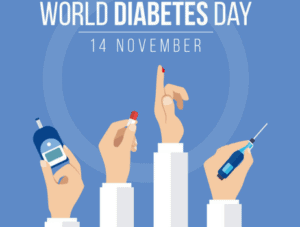The leaves have fallen, and we finally have a reprieve from the sweltering summer temperatures. Turkey, stuffing, and time with family are all just around the corner as we enter into the 2019 holiday season. Though visiting family and eating delicious home-cooked meals are staple holiday traditions, the nearly 30.3 million American patients who are trying to manage diabetes may face additional stressors during the season.
 Diabetes is one of the most serious public health issues. The disease occurs when blood glucose levels in the body are too high. Patients are diagnosed with diabetes if it is discovered that their pancreas does not make enough insulin or does not use insulin well. Overtime, unmanaged blood glucose levels can lead to heart disease, stroke, kidney disease, eye problems, and nerve damage. Managing blood glucose levels through diet or insulin medications can help to prevent some of the more serious health problems that the disease can cause.
Diabetes is one of the most serious public health issues. The disease occurs when blood glucose levels in the body are too high. Patients are diagnosed with diabetes if it is discovered that their pancreas does not make enough insulin or does not use insulin well. Overtime, unmanaged blood glucose levels can lead to heart disease, stroke, kidney disease, eye problems, and nerve damage. Managing blood glucose levels through diet or insulin medications can help to prevent some of the more serious health problems that the disease can cause.
World Diabetes Day was created in 1991 by the World Health Organization and International Diabetes Foundation in response to growing concerns about the health threats posed by diabetes. In 2006, World Diabetes Day became a recognized United Nations Day with November 14th chosen as the date in honor of Sir Frederick Banting, one of the co-discoverers of insulin. The World Diabetes Day campaign reaches an audience of over 1 billion people in more than 160 countries. The goal of the campaign is to bring awareness to the disease and keep it in the political spotlight.
Thanksgiving is one of the busiest travel times of the year with nearly 31 million passengers expected to use US airlines during the week of the holiday. In honor of World Diabetes Day and the start of the holiday season, physicians and researchers have identified the safest ways to travel with diabetes. We have rounded up the best medical tips:
- Visit your doctor before you go. Be sure to ask how planned activities and time differences could affect insulin dosage.
- Locate pharmacies in the region prior to travel just in case additional medications or supplies are needed
- A list of current medications and doctor’s names and phone numbers should be kept at all time
- Through its 24/7 medical operations center, VIGILINT offers services to help you locate the best facilities.
- To mitigate some of the risks involved in running out of medications or supplies, it is recommended that travelers carry twice as many supplies that they think they will need
- Get a medical identification bracelet that states that you have diabetes. In the case of an emergency, this will allow health care personnel to give you the best medical care possible based on your health needs.
- When packing, put diabetes supplies in a carry-on bag as insulin could get too cold in checked luggage and luggage could get lost.
- A TSA notification card will help the security process to go faster when carrying on these items.
- People with diabetes are exempt from the 3.4 oz liquid rule for medications and fast-acting carbs. Travelers should carry these supplies with them onto the plane.
If you or your traveling companion wind up in a diabetes-related medical emergency situation anywhere in the world, VIGILINT offers a comprehensive Global MedAssist Program (GMAP) including medical evacuation to your hospital of choice, access to our 24/7 Medical Operations Center, and our board-certified Emergency Medicine Physician team. Contact VIGILINT for more information: 1 (919) 914-0900.
